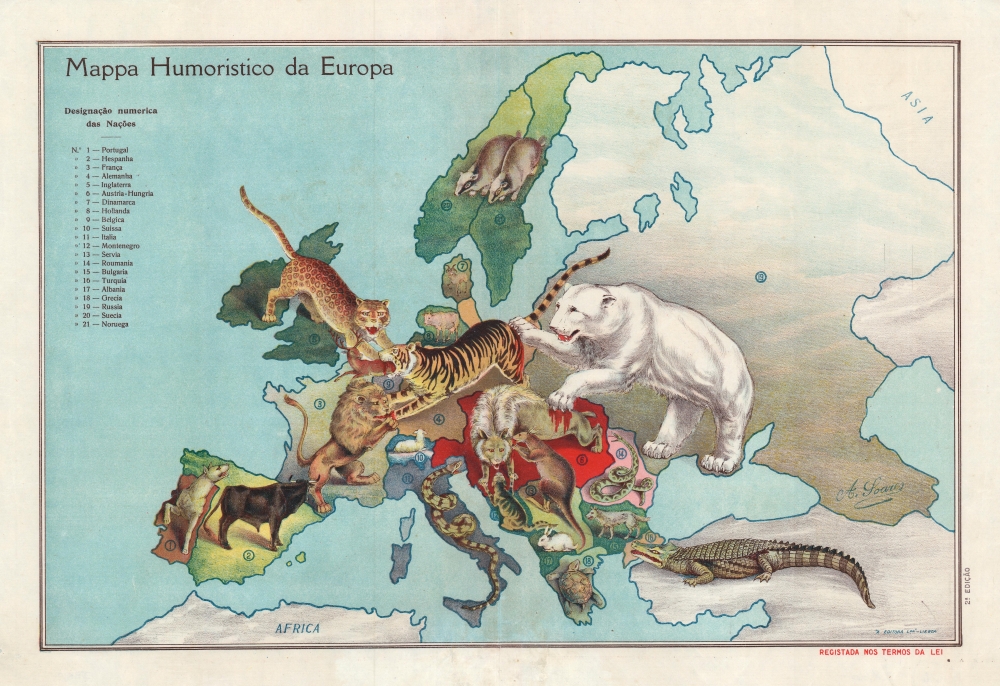This item has been sold, but you can get on the Waitlist to be notified if another example becomes available, or purchase a digital scan.
1914 Antonio Soares Serio-Comic Map of Europe: A Bloody Menagerie
MappaHumoristico-soares-1916
Title
1916 (undated) 12.5 x 19 in (31.75 x 48.26 cm)
Description
Play-By-Play
The players in the conflict - both active and passive - are represented by animals, which are numbered corresponding to a key. The aggressor nations are portrayed as predators. A wolf, Austria Hungary, (6) faces off with wildcat Montenegro (12) while Serbia (13, a Kangaroo) jumps in to bite the wolf in the neck. Germany, a tiger, (4) has already devoured half of the Belgian stag (9) despite Leonine France (3) having met Germany at the border and bloodied her paw. England, a leopard (5) belatedly jumps in to join the fight. Austria and Germany having presented her their backs, Russia, (19, inevitably a bear) takes advantage and bloodies them.The Spectators
The author's neutral home Portugal (1) is presented as a hound , who barks but does not bite. Neighboring Spain (2), also neutral, is a bull: unbloodied but watching France closely. The Danish goat and the Dutch cow (7 and 8 respectively) observe Belgium's fate and stay put; Switzerland, a lamb (10), has not even risen to its feet. Italy, a serpent (11) watches Austria/Hungary for an opportunity to strike - as does the coiled Romanian snake (14.) Neither the Bulgarian dog (15) nor the Turkish crocodile have entered hostilities, but appear eager to: the Albanian rabbit (17) and the Greek turtle appear inclined to sit them out. The twin honey badgers of Norway and Sweden (20, 21) huddle together defensively, and nobody seems to want to engage them anyway.Chromolithography
Chromolithography is a color lithographic technique developed in the mid-19th century. The process involved using multiple lithographic stones, one for each color, to yield a rich composite effect. Oftentimes, the process would start with a black basecoat upon which subsequent colors were layered. Some chromolithographs used 30 or more separate lithographic stones to achieve the desired effect. Chromolithograph color could also be effectively blended for even more dramatic results. The process became extremely popular in the late 19th and early 20th centuries, when it emerged as the dominate method of color printing. The vivid color chromolithography produced made it exceptionally effective for advertising and propaganda imagery.Publication History and Census
Soares produced this map in 1914, and evidently it sold with sufficient success that a further edition was warranted - though marked as such, no date is appended, but we estimate a date of 1916. No examples of this second state are catalogued in OCLC and a sole copy of the 1914 edition is held at the British Library.Cartographer
António Soares (September, 1894 – July, 1978) was a Portuguese modernist painter, caricaturist, architect, decorator, and set designer active during the early and middle 20th century. Soares was born in Lisbon and had no formal artistic training. He began his career as an illustrator, producing book covers, posters, caricature maps, and announcements, as well as working with magazines such as Ilustração, Magazine Bertrand and ABC. His work is generally modernist and includes caricature with a focus on worldly themes. Later in his career he began to focus on larger painting, murals, and even architectural decoration. Although little known today, he was well respected in his day. He won the Grand Prix at the Paris International Exposition in 1937, received the Columbano Prize twice at the SPN / SNI Modern Art Exhibitions (1935 and 1948), in 1958 was conferred the rank of officer of the Ordem Militar de Sant'Iago da Espada, and in 1962 received the Diário de Notícias Prize. More by this mapmaker...

